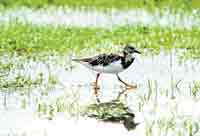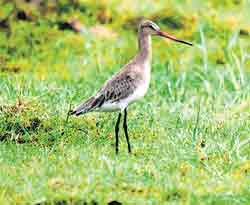
When various feathered ambassadors flock hereThis weekend is dedicated to the world’s migratory birds May 10 - 11 is being observed worldwide as World Migratory Bird Day (WMBD). This annual event created to raise awareness of the need to protect all migratory birds and their habitats, has as its theme “Migratory Birds- Ambassadors for Biodiversity” this year. It was initiated by the African-Eurasian Migratory Waterbird Agreement (UNEP/AEWA) in collaboration with the global Convention on Migratory Species (UNEP/CMS) - two international environmental treaties administered by the United Nations Environment Programme (UNEP).
Bird migration has fascinated mankind for centuries. Our ancestors who observed some birds suddenly disappearing from their area, could not explain this phenomenon. Some, on seeing night migrants believed birds were flying toward the moon. Others believed birds hibernated in caves in the jungles like bears during winter. But in fact, during the harsh winter in their native grounds, these migratory birds fly to areas with more favourable conditions. Migratory birds cross oceans and continents becoming an integral part of the global biological diversity. Their ability to link ecosystems, continents and people make migratory birds natural “ambassadors for biodiversity”. Their annual migrations not only help remind us of the interconnectedness of life on our planet, but also take them to some of the most biologically diverse areas on earth. Migrant birds represent half of the bird species recorded in Sri Lanka. The unique position of Sri Lanka in the Indian Ocean at the southernmost tip of the Indian subcontinent attracts a lot of migrants to it, mostly through the Central Asian Flyway. Some 262 birds migrate to Sri Lanka during the migratory season that starts from late August and continues upto March/April. Sri Lanka has signed the Convention on Migratory Species (CMS) commonly known as the Bonn Convention. The Department of Wildlife Conservation is responsible for protecting these bird ambassadors while they are in our island (protection is assured through the Fauna and Flora Ordinance). However, migratory birds are, on average, more at risk of becoming endangered than non-migratory species. This is so because their needs are greater: not only do they need good habitat for reproduction but also during their stay and all along their migratory routes. A loss of a site they used to rest can be devastating to a whole population that migrates through that flyway.
By far the largest threat to birds is the loss of habitat. Deforestation, the draining of wetlands, planting of non-native trees, the loss of areas to urban developments and intensive agriculture are major threats to birds. Many species are in serious decline as a result of habitat loss and these losses are particularly serious on islands, where bird populations are often small and fragile. Climate change too is a great threat to the migrants. When birds reach their destinations they rely on certain foods. A rise in temperature affects smaller animals and will ultimately affect migratory birds. Breeding success in some species, such as insect-eating songbirds, could be jeopardized due to a mismatch between the peak of availability of food and hatching of chicks. Climate change leads to changes and shifts in habitats, which causes re-distribution of birds, too. Some species are threatened by the almost complete loss of their habitat.
The number of birds that Migrate to Sri Lanka Source: Fauna of Sri Lanka – IUCN Winter visitor - 127 Total - 262 |
|
||||||
|| Front
Page | News | Editorial | Columns | Sports | Plus | Financial
Times | International | Mirror | TV
Times | Funday
Times || |
| |
Reproduction of articles permitted when used without any alterations to contents and a link to the source page.
|
© Copyright
2008 | Wijeya
Newspapers Ltd.Colombo. Sri Lanka. All Rights Reserved. |

